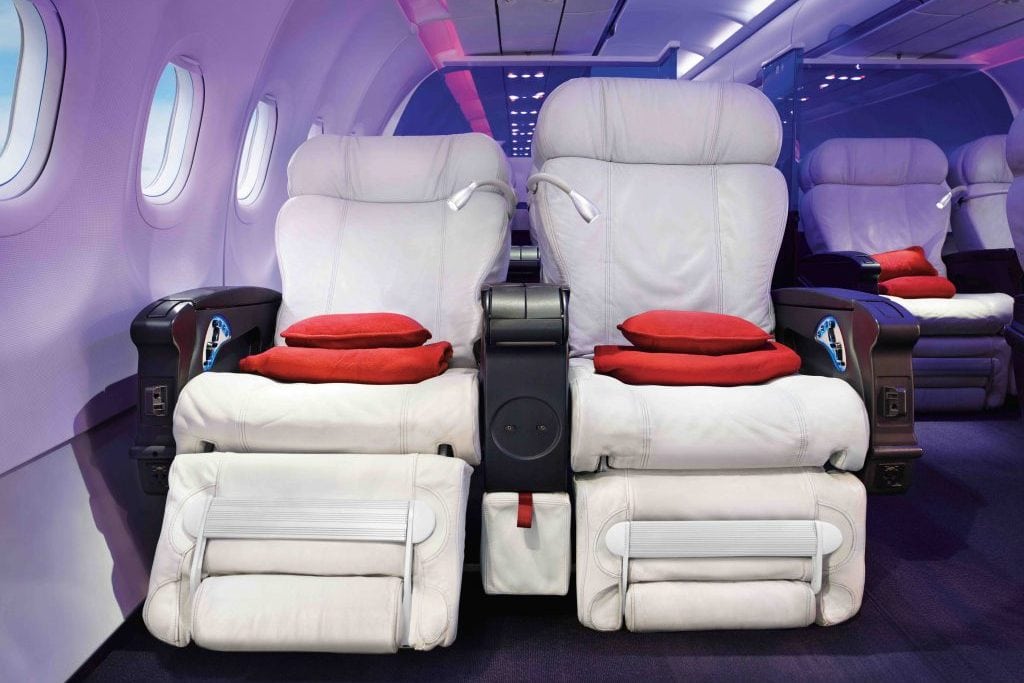Alaska Air Still Holding Off Big Decisions About Virgin America's Future

Skift Take
Alaska Airlines likely will not make any decisions about the future of Virgin America's brand until at least the fourth quarter of this year, Virgin America CEO David Cush said Monday.
At times, Alaska Airlines CEO Brad Tilden has hinted his carrier might find use for the upstart airline's brand after the two airlines merge. While Tilden once suggested it might be possible for Alaska to keep the two carriers separate, as International Airlines Group does with its British Airway and Iberia Airlines units, that's highly unlikely, as it would be a complex way to run a company. Instead, Alaska might absorb pieces of what makes Virgin America unique, such as mood lighting or even the words, like Main Cabin Select, that Virgin America uses to describe its passenger cabins.
The CEOs of Etihad, Expedia, Routehappy, and More Are Speaking at Skift Global Forum 2016. Join Us.
On Monday at the International Aviation Forecast Summit in Olympic Valley, California, Cush said he does not expect Alaska to make any decisions until after the merger closes, expected in the last three months of the year. Until then, Alaska has limited access to information about Virgin America's finances and strategy.
"They have some tough decisions to make about the brand and the product," Cush said. "Those really aren't decisions they can make until they are inside and have access to data."
Cush said the merger is still on schedule to close in the fourth quarter, after which point Cush will leave the company. The U.S. Department of Justice must clear the merger. Cush said the two carriers have "a number of weeks to go," before they're one company.
"Everything is going according to plan," Cush said. "There have been no bumps on the road."
Future of Virgin America's Products
There is at least one element of Virgin America's product that Alaska may not retain. Virgin America allows passengers to place food orders on in-seat screens, and meals and snacks are delivered by flight attendants. Alaska does not have in-seat screens, so that would make it a difficult service element for it to adopt. But there's another challenge: Most airline union contracts limit how flight attendants can serve passengers.
"It is as much a labor issue as a technology issue," Cush said. "It is a change in the work rules and therefore it becomes a union issue."
(Virgin America's flight attendants have a union, but the union has not yet ratified a first contract.)
Alaska must also decide what to do with Virgin America's trans-continental business class cabin, particularly on aircraft flying from San Francisco and Los Angeles to New York JFK and Newark. Cush acknowledged his airline's eight-seat business class cabin, which lacks lie-flat beds, is not necessarily competitive with flat-beds offered American Airlines, Delta Air Lines, United Airlines, or JetBlue Airways. This is an issue, as Cush said those flights accounts for roughly 40 percent of Virgin America's revenue.
Cush said Virgin America decided not to install flat-beds because it calculated it would cost too much while generating little extra revenue. The airline would have had to remove a row of coach seats, at the same time business class fares in the markets were falling.
Several years ago, Cush said, it was normal to have $2,000 one-way fares between California and New York. Now the average fare is about half that, Cush said, with many airlines charging as little as $599 or $699 for a one-way. JetBlue is mostly responsible for that dip, as it introduced its Mint cabin in 2014 with prices far lower than what competitors were charging. Other airlines generally have matched its fares.
"I don't know how that math works," Cush said. "The 'transcon' market is a bit of a wasteland compared to where it was before."
For now, Virgin America is still selling its recliner seats for roughly the same prices as other airlines charge for flatbeds, and Cush said carrier is mostly holding onto revenue. But Alaska may decide it needs a more competitive product for its transcontinental flights.
Alaska will also need to make some decisions on Virgin America's fleet. Virgin America now has 63 Airbus A319s and A320s, while Alaska has only Boeing 737s in its mainline fleet. Virgin America has 40 Airbus aircraft on order, and the future of those are "up for negotiation," Cush said. An Alaska executive has said the new orders have "favorable" cancelation provisions.
Still, it's too early to know for sure how Alaska will proceed with Virgin America.
"Once the merger closes they will come in and do what Alaska does best, which is analyze and make the right decisions," Cush said.




